Demarcation of Coordinated Prevention and Control Regions in the Yangtze River Delta Based on Spatio-Temporal Variations in PM2.5 and O3 Concentrations
Abstract
:1. Introduction
2. Materials and Methods
2.1. Study Area
2.2. Data Sources
2.2.1. Ground-Monitored Air Pollutant Data
2.2.2. Remote Sensing Data on PM2.5 and O3
2.2.3. Other Data
2.3. Methods
2.3.1. Trend Analysis
2.3.2. Division of Pollution Prevention and Control Regions
3. Results and Discussion
3.1. Temporal Variations in PM2.5 and O3 Concentrations in the YRD
3.2. Spatial Variations in PM2.5 and O3 Concentrations in the YRD
3.3. PM2.5 and O3 Pollution in YRD Cities from 2015 to 2020
3.4. Pollution Types and Regional Division of Coordinated Prevention and Control Programs in the YRD
4. Conclusions
- (1)
- The temporal and spatial distribution of PM2.5 and O3 pollution are closely related to topographical and meteorological conditions. The YRD region has high O3 pollution in summer and high PM2.5 pollution in winter, while co-pollution of PM2.5 and O3 is most significant in spring and covers 67.5% of the area. The most serious PM2.5 and O3 pollution occurs in the northern part of the YRD, while the air quality is generally better in the southwestern mountainous area.
- (2)
- During the period 2015 to 2020, the main pollution type in the YRD changes from PM2.5 pollution to O3 pollution. The areas of changed pollution are basically consistent with the predictions, which shows that our method is reliable in guiding pollution control.
- (3)
- In view of the trend of decreasing PM2.5 and increasing O3 of air pollution in the YRD, a strategy of focusing on VOCs first and then NOx should be implemented in Anhui, Jiangsu, and Shanghai, with greater attention paid to the former two. Jiangsu and Anhui must actively respond to regional coordinated prevention and control programs and focus on transforming their industry and energy structures.
Author Contributions
Funding
Institutional Review Board Statement
Informed Consent Statement
Data Availability Statement
Acknowledgments
Conflicts of Interest
Appendix A
- (1)
- Comparing the importance of the four indicators (PM2.5 concentration ρ(PM2.5), O3 concentration ρ(O3), the rates of change r(PM2.5) and r(O3)) in pairs, and their proportions are obtained by the value of the quadratic curve fitting;
- (2)
- Comprehensively sort out all the ratios obtained from the pairwise comparisons, thereby constructing the judgment matrix of the four indicators, which is subjective to a certain extent;
- (3)
- Calculating the weight vectors and perform the consistency check.
| ρ(PM2.5) | ρ(O3) | r(PM2.5) | r(O3) | |
|---|---|---|---|---|
| ρ(PM2.5) | 1 | 2 | 1/2 | 2 |
| ρ(O3) | 1/2 | 1 | 1/3 | 1 |
| r(PM2.5) | 2 | 3 | 1 | 3 |
| r(O3) | 1/2 | 1 | 1/3 | 1 |
| Indicator | Eigenvector | Weight | Maximal Eigenvalue | CI * |
|---|---|---|---|---|
| ρ(PM2.5) | 1.1892 | 0.2627 | 4.0104 | 0.0035 |
| ρ(O3) | 0.6389 | 0.1411 | ||
| r(PM2.5) | 2.0598 | 0.455 | ||
| r(O3) | 0.6389 | 0.1411 |
Appendix B

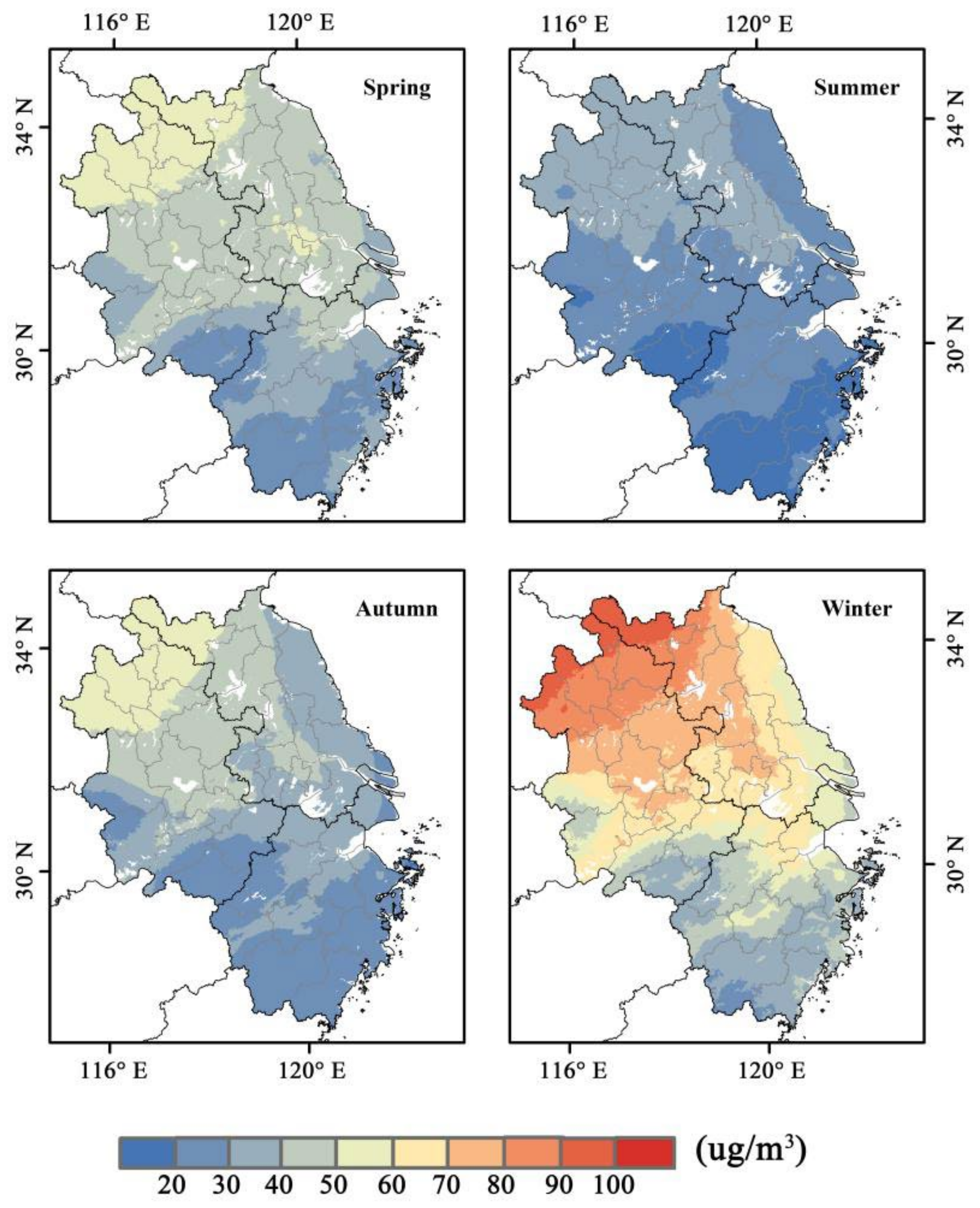
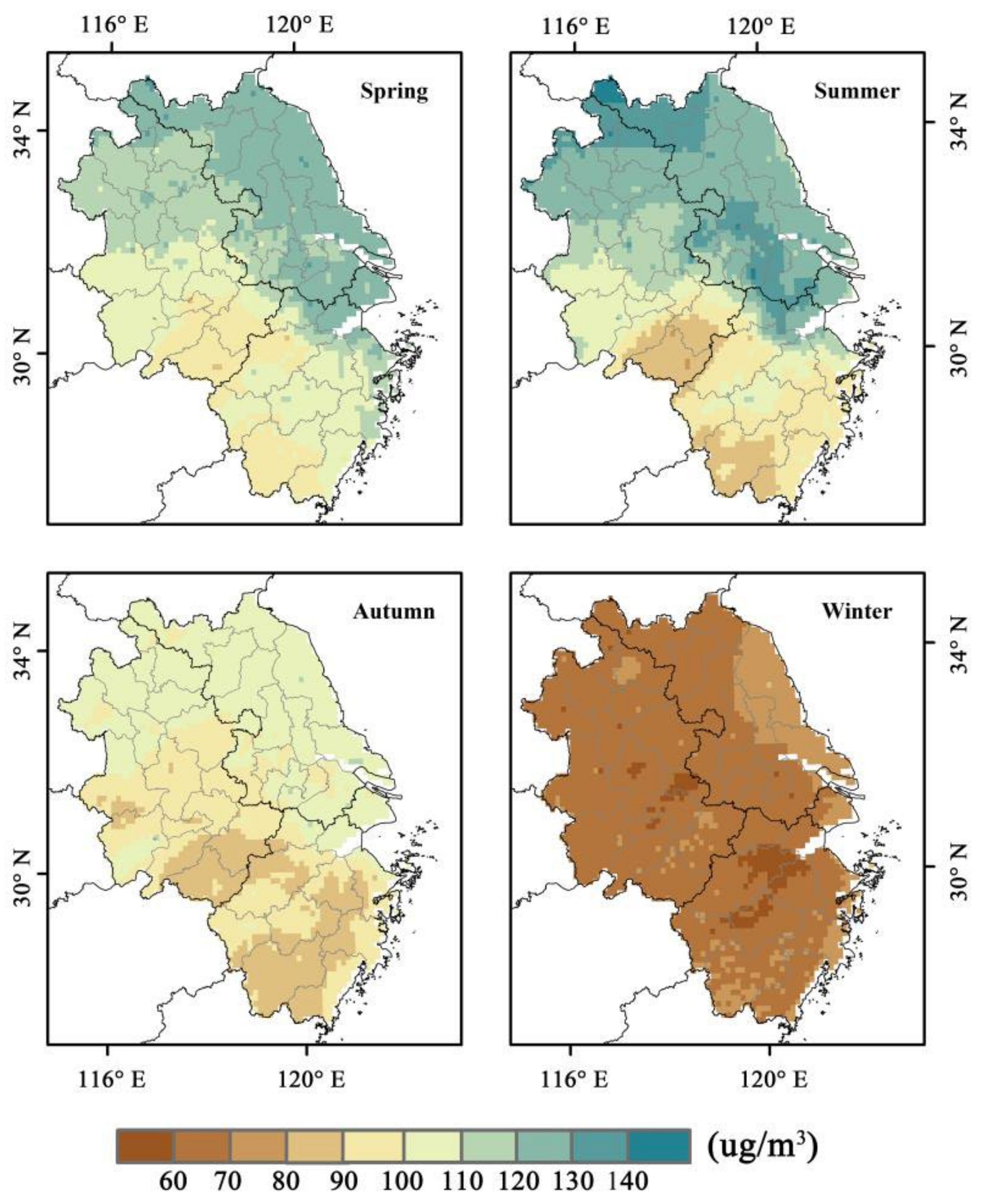
| Pollution Type | Area |
|---|---|
| High PM2.5 pollution | 1.8% |
| High O3 pollution | 0.2% |
| High co-pollution | 38% |
| PM2.5 pollution to co-pollution | 3.9% |
| PM2.5 to O3 pollution | 6.7% |
| Co-pollution to O3 pollution | 15.9% |
| PM2.5 pollution to low pollution | 9.1% |
| Low pollution to O3 pollution | 3.5% |
| Good air quality | 20.9% |
References
- Peng, J.; Wang, X.; Liu, Y.; Zhao, Y.; Xu, Z.; Zhao, M.; Qiu, S.; Wu, J. Urbanization impact on the supply-demand budget of ecosystem services: Decoupling analysis. Ecosyst. Serv. 2020, 44, 101139. [Google Scholar] [CrossRef]
- China National Environmental Monitoring Centre (CNEMC). Available online: http://www.cnemc.cn/jcbg/ (accessed on 14 July 2022).
- China National Environmental Monitoring Centre (CNEMC). Available online: http://www.cnemc.cn/jcbg/zghjzkgb/202105/W020210527493805924492.pdf (accessed on 14 July 2022).
- Lelieveld, J.; Pozzer, A.; Pöschl, U.; Fnais, M.; Haines, A.; Münzel, T. Loss of life expectancy from air pollution compared to other risk factors: A worldwide perspective. Cardiovasc. Res. 2020, 116, 1910–1917. [Google Scholar] [CrossRef] [PubMed]
- Orellano, P.; Reynoso, J.; Quaranta, N.; Bardach, A.; Ciapponi, A. Short-term exposure to particulate matter (PM10 and PM2.5), nitrogen dioxide(NO2), and ozone(O3) and all-cause and cause-specific mortality: Systematic review and meta-analysis. Environ. Int. 2020, 142, 105876. [Google Scholar] [CrossRef] [PubMed]
- Zhang, N.N.; Ma, F.; Qin, C.B.; Li, Y.F. Spatiotemporal trends in PM2.5 levels from 2013 to 2017 and regional demarcations for joint prevention and control of atmospheric pollution in China. Chemosphere 2018, 210, 1176–1184. [Google Scholar] [CrossRef]
- Maji, K.J.; Dikshit, A.K.; Arora, M.; Deshpande, A. Estimating premature mortality attributable to PM2.5 exposure and benefit of air pollution control policies in China for 2020. Sci. Total Environ. 2018, 612, 683–693. [Google Scholar] [CrossRef]
- Li, S.X.; Zou, B.; Zhang, F.Y.; Liu, N.; Xue, C.H.; Liu, J. Regionalization and Analysis of PM2.5 and O3 Synergetic Prevention and Control Areas Based on Remote Sensing Data. Environ. Sci. 2022. [Google Scholar] [CrossRef]
- Li, M.; Wang, L.; Liu, J.; Gao, W.; Song, T.; Sun, Y.; Li, L.; Li, X.; Wang, Y.; Liu, L.; et al. Exploring the regional pollution characteristics and meteorological formation mechanism of PM2.5 in North China during 2013–2017. Environ. Int. 2020, 134, 105283. [Google Scholar] [CrossRef]
- Yan, D.; Lei, Y.; Shi, Y.; Zhu, Q.; Li, L.; Zhang, Z. Evolution of the spatiotemporal pattern of PM2.5 concentrations in China—A case study from the Beijing-Tianjin-Hebei region. Atmos. Environ. 2018, 183, 225–233. [Google Scholar] [CrossRef]
- Fang, C.; Wang, L.; Li, Z.; Wang, J. Spatial Characteristics and Regional Transmission Analysis of PM2.5 Pollution in Northeast China, 2016–2020. Int. J. Environ. Res. Public Health 2021, 18, 12483. [Google Scholar] [CrossRef]
- Li, N.; He, Q.; Greenberg, J.; Guenther, A.; Li, J.; Cao, J.; Wang, J.; Liao, H.; Wang, Q.; Zhang, Q. Impacts of biogenic and anthropogenic emissions on summertime ozone formation in the Guanzhong Basin, China. Atmos. Chem. Phys. 2018, 18, 7489–7507. [Google Scholar] [CrossRef]
- Li, K.; Chen, L.; Ying, F.; White, S.J.; Jang, C.; Wu, X.; Gao, X.; Hong, S.; Shen, J.; Azzi, M.; et al. Meteorological and chemical impacts on ozone formation: A case study in Hangzhou, China. Atmos. Res. 2017, 196, 40–52. [Google Scholar] [CrossRef]
- Chen, Z.; Chen, D.; Zhao, C.; Kwan, M.; Cai, J.; Zhuang, Y.; Zhao, B.; Wang, X.; Chen, B.; Yang, Y.; et al. Influence of meteorological conditions on PM2.5 concentrations across China: A review of methodology and mechanism. Environ. Int. 2020, 139, 105558. [Google Scholar] [CrossRef]
- Xiao, Q.; Geng, G.; Liang, F.; Wang, X.; Lv, Z.; Lei, Y.; Huang, X.; Zhang, Q.; Liu, Y.; He, K. Changes in spatial patterns of PM2.5 pollution in China 2000–2018: Impact of clean air policies. Environ. Int. 2020, 141, 105776. [Google Scholar] [CrossRef]
- Wang, W.N.; Cheng, T.H.; Gu, X.F.; Chen, H.; Guo, H.; Wang, Y.; Bao, F.W.; Shi, S.Y.; Xu, B.R.; Zuo, X.; et al. Assessing spatial and temporal patterns of observed ground-level ozone in China. Sci. Rep. 2017, 7, 3651. [Google Scholar] [CrossRef]
- Wang, L.; Xiong, Q.; Wu, G.; Gautam, A.; Jiang, J.; Liu, S.; Zhao, W.; Guan, H. Spatio-temporal variation characteristics of PM2.5 in the Beijing-Tianjin-Hebei Region, China, from 2013 to 2018. Int. J. Environ. Res. Public Health 2019, 16, 4276. [Google Scholar] [CrossRef]
- Liu, H.; Liu, J.; Liu, Y.; Yi, K.; Yang, H.; Xiang, S.; Ma, J.; Tao, S. Spatiotemporal variability and driving factors of ground-level summertime ozone pollution over eastern China. Atmos. Environ. 2021, 265, 118686. [Google Scholar] [CrossRef]
- Lou, Y.; Teng, M.; Yang, K.; Zhu, Y.; Zhou, X.; Zhang, M.; Shi, Y. Research on PM2.5 estimation and prediction method and changing characteristics analysis under long temporal and large spatial scale-A case study in China typical regions. Sci. Total Environ. 2019, 696, 133983. [Google Scholar]
- Tan, J.; Zhang, Y.; Ma, W.; Yu, Q.; Wang, J.; Chen, L. Impact of spatial resolution on air quality simulation: A case study in a highly industrialized area in Shanghai, China. Atmos. Pollut. Res. 2015, 6, 322–333. [Google Scholar] [CrossRef]
- Thompson, T.M.; Selin, N.E. Influence of air quality model resolution on uncertainty associated with health impacts. Atmos. Chem. Phys. 2012, 12, 9753–9762. [Google Scholar] [CrossRef]
- Tao, H.; Xing, J.; Zhou, H.; Pleim, J.; Ran, L.; Chang, X.; Wang, S.; Chen, F.; Zheng, H.; Li, J. Impacts of improved modeling resolution on the simulation of meteorology, air quality, and human exposure to PM2.5, O3 in Beijing, China. J. Clean. Prod. 2020, 243, 118574. [Google Scholar] [CrossRef]
- Wang, H.; Zhao, L. A joint prevention and control mechanism for air pollution in the Beijing-Tianjin-Hebei region in china based on long-term and massive data mining of pollutant concentration. Atmos. Environ. 2018, 174, 25–42. [Google Scholar] [CrossRef]
- Xie, Y.; Zhao, L.; Xue, J.; Gao, H.; Li, H.; Jiang, R.; Qiu, X.; Zhang, S. Methods for defining the scopes and priorities for joint prevention and control of air pollution regions based on data-mining technologies. J. Clean. Prod. 2018, 185, 912–921. [Google Scholar] [CrossRef]
- Zhang, N.; Guan, Y.; Li, Y.F.; Wang, S. New region demarcation method for implementing the Joint Prevention and Control of Atmospheric Pollution policy in China. J. Clean. Prod. 2021, 325, 129345. [Google Scholar] [CrossRef]
- Zhang, D.; Wang, X.; Qu, L.; Li, S.; Lin, Y.; Yao, R.; Zhou, X.; Li, J. Land use/cover predictions incorporating ecological security for the Yangtze River Delta region, China. Ecol. Indic. 2020, 119, 106841. [Google Scholar] [CrossRef]
- Ministry of Ecology and Environment (MEE). Available online: http://www.mee.gov.cn/xxgk2018/xxgk/xxgk01/201808/t20180815_629602.html (accessed on 14 July 2022).
- Wei, J.; Li, Z.; Lyapustin, A.; Sun, L.; Peng, Y.; Xue, W.; Su, T.; Cribb, M. Reconstructing 1-km-resolution high-quality PM2.5 data records from 2000 to 2018 in China: Spatiotemporal variations and policy implications. Remote Sens. Environ. 2021, 252, 112136. [Google Scholar] [CrossRef]
- Wei, J.; Li, Z.; Li, K.; Dickerson, R.R.; Pinker, R.T.; Wang, J.; Liu, X.; Sun, L.; Xue, W.; Cribb, M. Full-coverage mapping and spatiotemporal variations of ground-level ozone (O3) pollution from 2013 to 2020 across China. Remote Sens. Environ. 2022, 270, 112775. [Google Scholar] [CrossRef]
- Mudelsee, M. Trend analysis of climate time series: A review of methods. Earth-Sci. Rev. 2019, 190, 310–322. [Google Scholar] [CrossRef]
- Ye, Q.; Liu, H.; Lin, Y.; Han, R. Study of Maowusu sandy land vegetation coverage change based on modis Ndvi. ISPRS-Int. Arch. Photogramm. Remote Sens. Spat. Inf. Sci. 2018, 42, 2127–2133. [Google Scholar] [CrossRef]
- Yang, Q.; Yuan, Q.; Li, T.; Shen, H.; Zhang, L. The relationships between PM2.5 and meteorological factors in China: Seasonal and regional variations. Int. J. Environ. Res. Public Health 2017, 14, 1510. [Google Scholar] [CrossRef]
- U.S. Environmental Protection Agency (EPA). Available online: https://www.epa.gov/air-trends/trends-ozone-adjusted-weather-conditions (accessed on 8 August 2022).
- Zhang, T.Y.; Shen, N.; Zhao, X.; Wang, X.; Zhao, W. Spatiotemporal variation characteristics of ozone and its population exposure risk assessment in Chengdu-Chongqing urban agglomeration during 2015 to 2019. Acta Sci. Circumstantiae. 2021, 41, 4188–4199. [Google Scholar]
- Wang, J.; Zhang, X.; Li, D.; Yang, Y.; Zhong, J.; Wang, Y.; Che, H.; Che, H.; Zhang, Y. Interdecadal changes of summer aerosol pollution in the Yangtze River Basin of China, the relative influence of meteorological conditions and the relation to climate change. Sci. Total Environ. 2018, 630, 46–52. [Google Scholar] [CrossRef] [PubMed]
- Li, Z.; Yu, S.; Li, M.; Chen, X.; Zhang, Y.; Song, Z.; Li, J.; Jiang, Y.; Liu, W.; Li, P.; et al. The Modeling Study about Impacts of Emission Control Policies for Chinese 14th Five-Year Plan on PM2.5 and O3 in Yangtze River Delta, China. Atmosphere 2021, 13, 26. [Google Scholar] [CrossRef]
- Mousavinezhad, S.; Choi, Y.; Pouyaei, A.; Ghahremanloo, M.; Nelson, D.L. A comprehensive investigation of surface ozone pollution in China, 2015–2019: Separating the contributions from meteorology and precursor emissions. Atmos. Res. 2021, 257, 105599. [Google Scholar] [CrossRef]
- Hu, C.; Kang, P.; Jaffe, D.A.; Li, C.; Zhang, X.; Wu, K.; Zhou, M. Understanding the impact of meteorology on ozone in 334 cities of China. Atmos. Environ. 2021, 248, 118221. [Google Scholar] [CrossRef]
- Wang, P.; Guo, H.; Hu, J.; Kota, S.H.; Ying, Q.; Zhang, H. Responses of PM2.5 and O3 concentrations to changes of meteorology and emissions in China. Sci. Total Environ. 2019, 662, 297–306. [Google Scholar] [CrossRef]
- Shu, L.; Xie, M.; Gao, D.; Wang, T.; Fang, D.; Liu, Q.; Huang, A.; Peng, L. Regional severe particle pollution and its association with synoptic weather patterns in the Yangtze River Delta region, China. Atmos. Chem. Phys. 2017, 17, 12871–12891. [Google Scholar] [CrossRef]
- Zhou, C.; Wei, G.; Zheng, H.; Russo, A.; Li, C.; Du, H.; Xiang, J. Effects of potential recirculation on air quality in coastal cities in the Yangtze River Delta. Sci. Total Environ. 2019, 651, 12–23. [Google Scholar] [CrossRef]
- Wang, X.; Dickinson, R.E.; Su, L.; Zhou, C.; Wang, K. PM2.5 pollution in China and how it has been exacerbated by terrain and meteorological conditions. Bull. Am. Meteorol. Soc. 2018, 99, 105–119. [Google Scholar] [CrossRef]
- Wang, X.C.; Klemeš, J.J.; Dong, X.; Fang, W.; Xu, Z.; Wang, Y.; Varbanov, P.S. Air pollution terrain nexus: A review considering energy generation and consumption. Renew. Sustain. Energy Rev. 2019, 105, 71–85. [Google Scholar] [CrossRef]
- Zhang, Q.; Zheng, Y.; Tong, D.; Li, F.; Zhang, W.; Li, W.; Wang, Z.; Zhang, G.; Tang, G.; Liu, Z.; et al. Drivers of improved PM2.5 air quality in China from 2013 to 2017. Proc. Natl. Acad. Sci. USA 2019, 116, 24463–24469. [Google Scholar] [CrossRef]
- Shi, C.; Nduka, I.C.; Yang, Y.; Huang, Y.; Yao, R.; Zhang, H.; He, B.; Xie, C.; Wang, Z.; Yim, S.H.L. Characteristics and meteorological mechanisms of transboundary air pollution in a persistent heavy PM2.5 pollution episode in Central-East China. Atmos. Environ. 2020, 223, 117239. [Google Scholar] [CrossRef]
- Zhao, D.; Xin, J.; Wang, W.; Jia, D.; Wang, Z.; Xiao, H.; Liu, C.; Zhou, J.; Tong, L.; Ma, Y.; et al. Effects of the sea-land breeze on coastal ozone pollution in the Yangtze River Delta, China. Sci. Total Environ. 2022, 807, 150306. [Google Scholar] [CrossRef]
- Wang, L.; Lyu, B.; Bai, Y. Aerosol vertical profile variations with seasons, air mass movements and local PM2.5 levels in three large China cities. Atmos. Environ. 2020, 224, 117329. [Google Scholar] [CrossRef]
- Dai, H.; Zhu, J.; Liao, H.; Li, J.; Liang, M.; Yang, Y.; Yue, X. Co-occurrence of ozone and PM2.5 pollution in the Yangtze River Delta over 2013–2019: Spatiotemporal distribution and meteorological conditions. Atmos. Res. 2021, 249, 105363. [Google Scholar] [CrossRef]
- Xiang, S.; Liu, J.; Tao, W.; Yi, K.; Xu, J.; Hu, X.; Liu, H.; Wang, Y.; Zhang, Y.; Yang, H.; et al. Control of both PM2.5 and O3 in Beijing-Tianjin-Hebei and the surrounding areas. Atmos. Environ. 2020, 224, 117259. [Google Scholar] [CrossRef]
- Li, L.; Hu, J.; Li, J.; Gong, K.; Wang, X.; Ying, Q.; Qin, M.; Liao, H.; Guo, S.; Hu, M.; et al. Modelling air quality during the EXPLORE-YRD campaign—Part II. Regional source apportionment of ozone and PM2.5. Atmos. Environ. 2021, 247, 118063. [Google Scholar] [CrossRef]
- Li, K.; Jacob, D.J.; Liao, H.; Shah, V.; Shen, L.; Bates, K.H.; Zhang, Q.; Zhai, S. A two-pollutant strategy for improving ozone and particulate air quality in China. Nat. Geosci. 2019, 12, 906–910. [Google Scholar] [CrossRef]
- Li, K.; Jacob, D.J.; Shen, L.; Lu, X.; Smedt, L.D.; Liao, H. Increases in surface ozone pollution in China from 2013 to 2019: Anthropogenic and meteorological influences. Atmos. Chem. Phys. 2020, 20, 11423–11433. [Google Scholar] [CrossRef]
- Li, L.; Li, Q.; Huang, L.; Wang, Q.; Zhu, A.; Xu, J.; Liu, Z.; Li, H.; Shi, L.; Li, R.; et al. Air quality changes during the COVID-19 lockdown over the Yangtze River Delta Region: An insight into the impact of human activity pattern changes on air pollution variation. Sci. Total Environ. 2020, 732, 139282. [Google Scholar] [CrossRef]
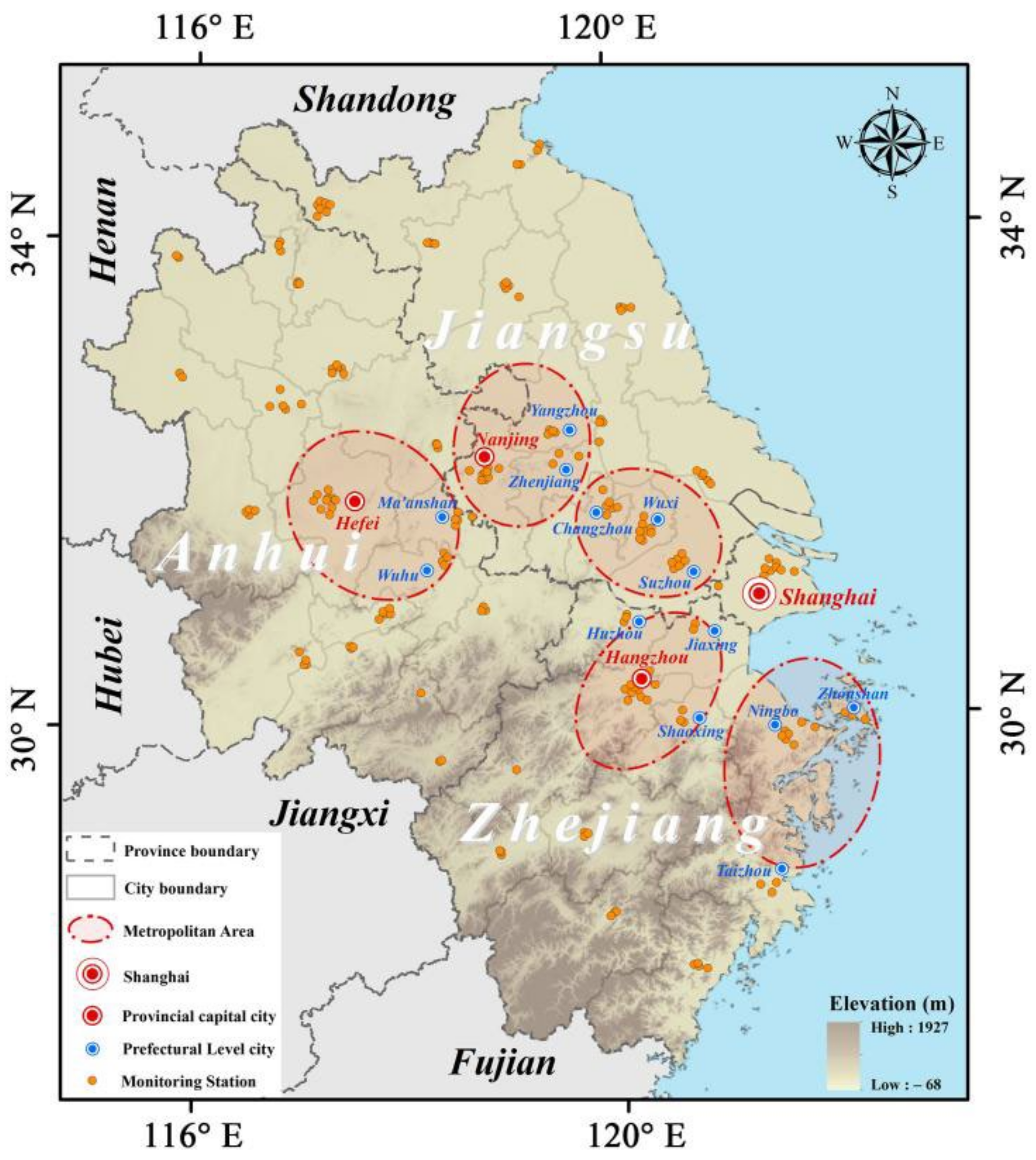
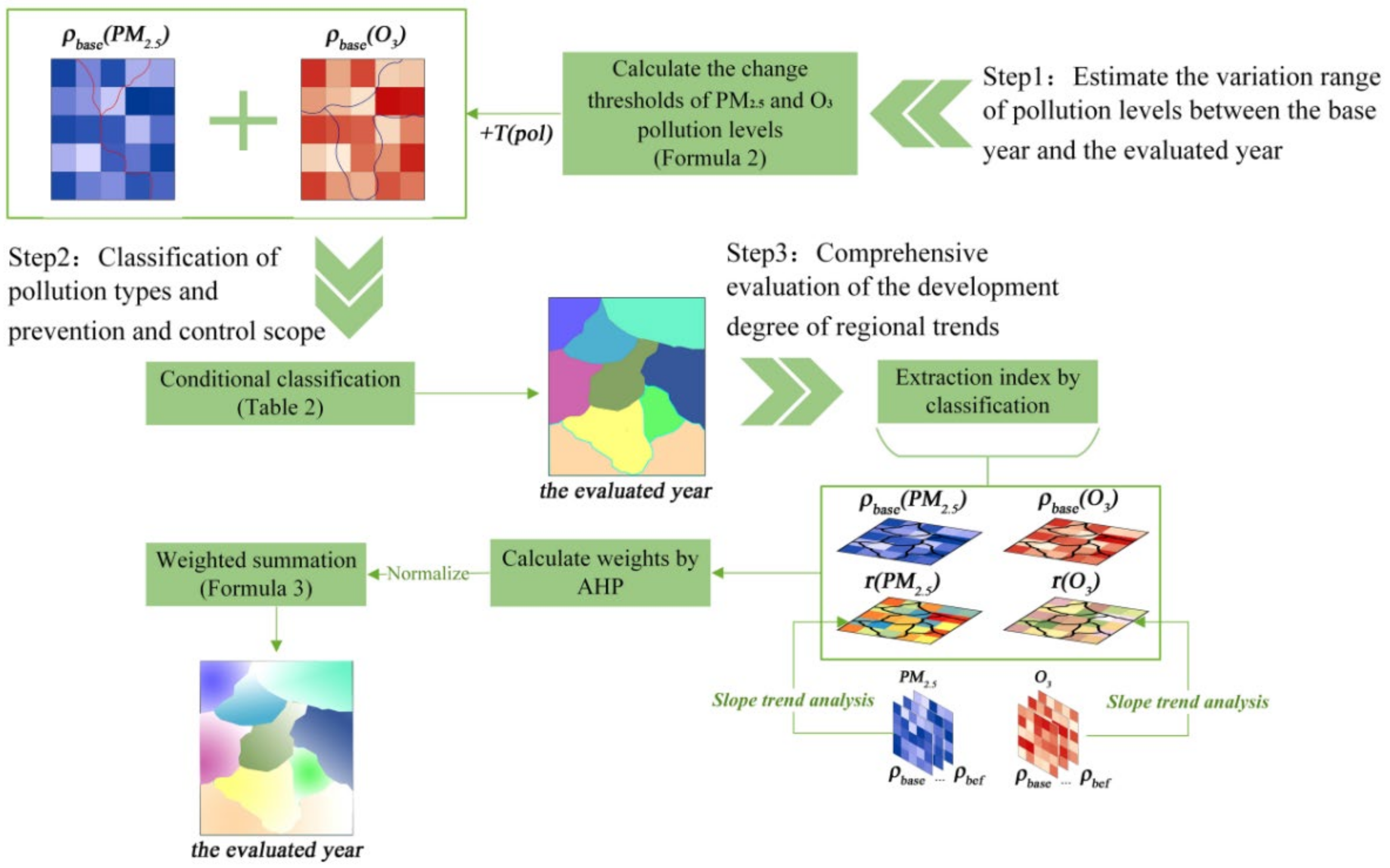

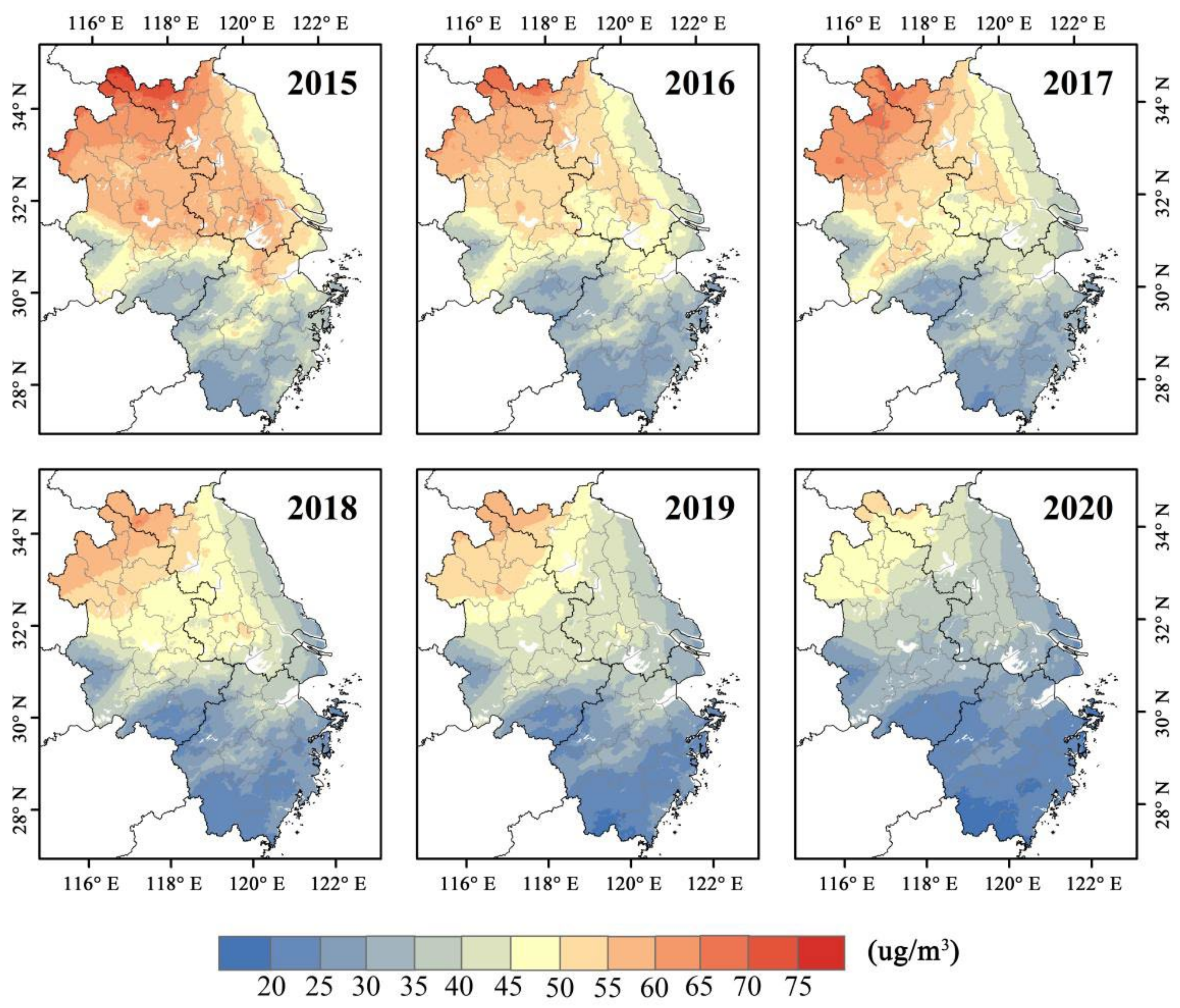
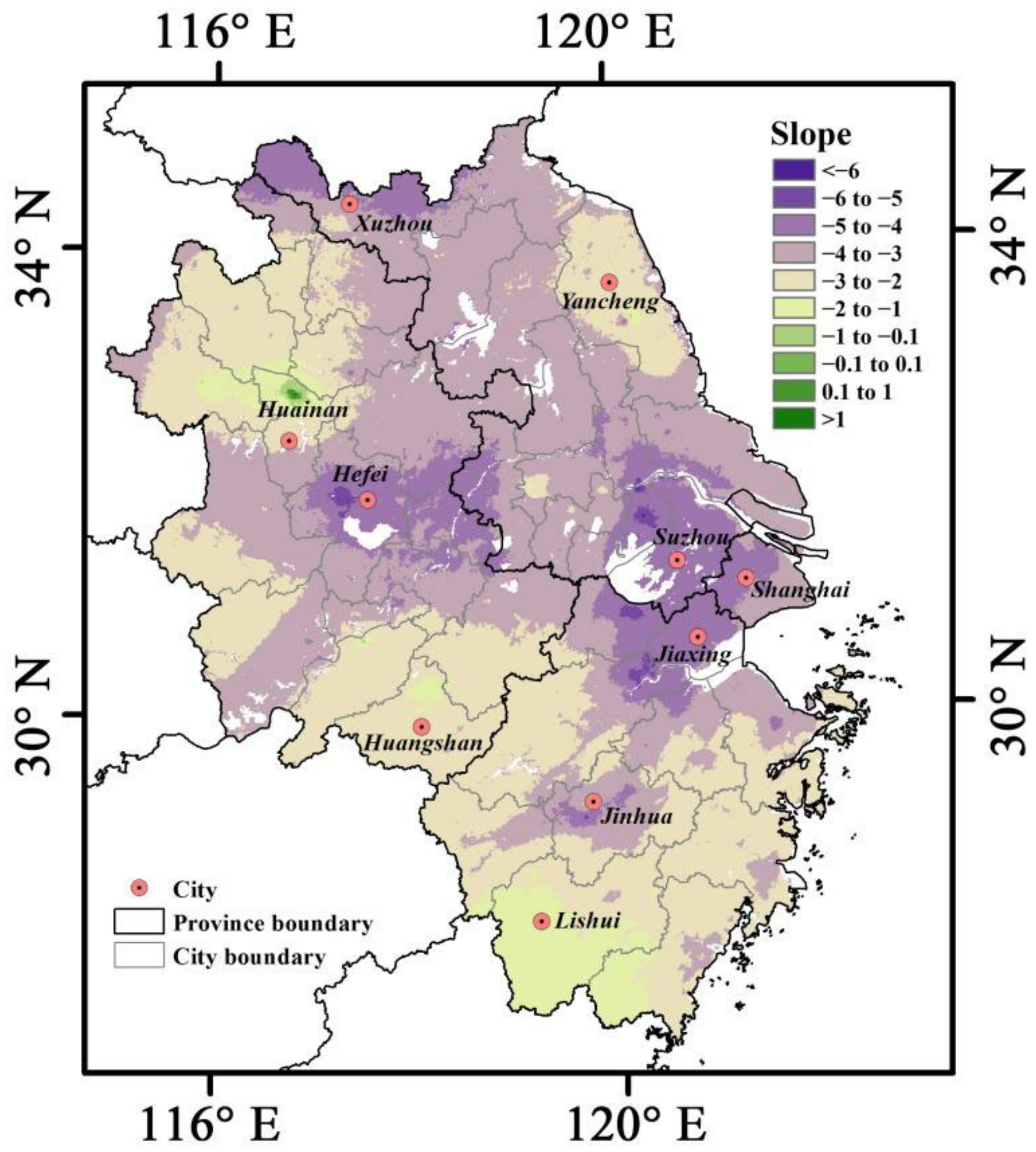
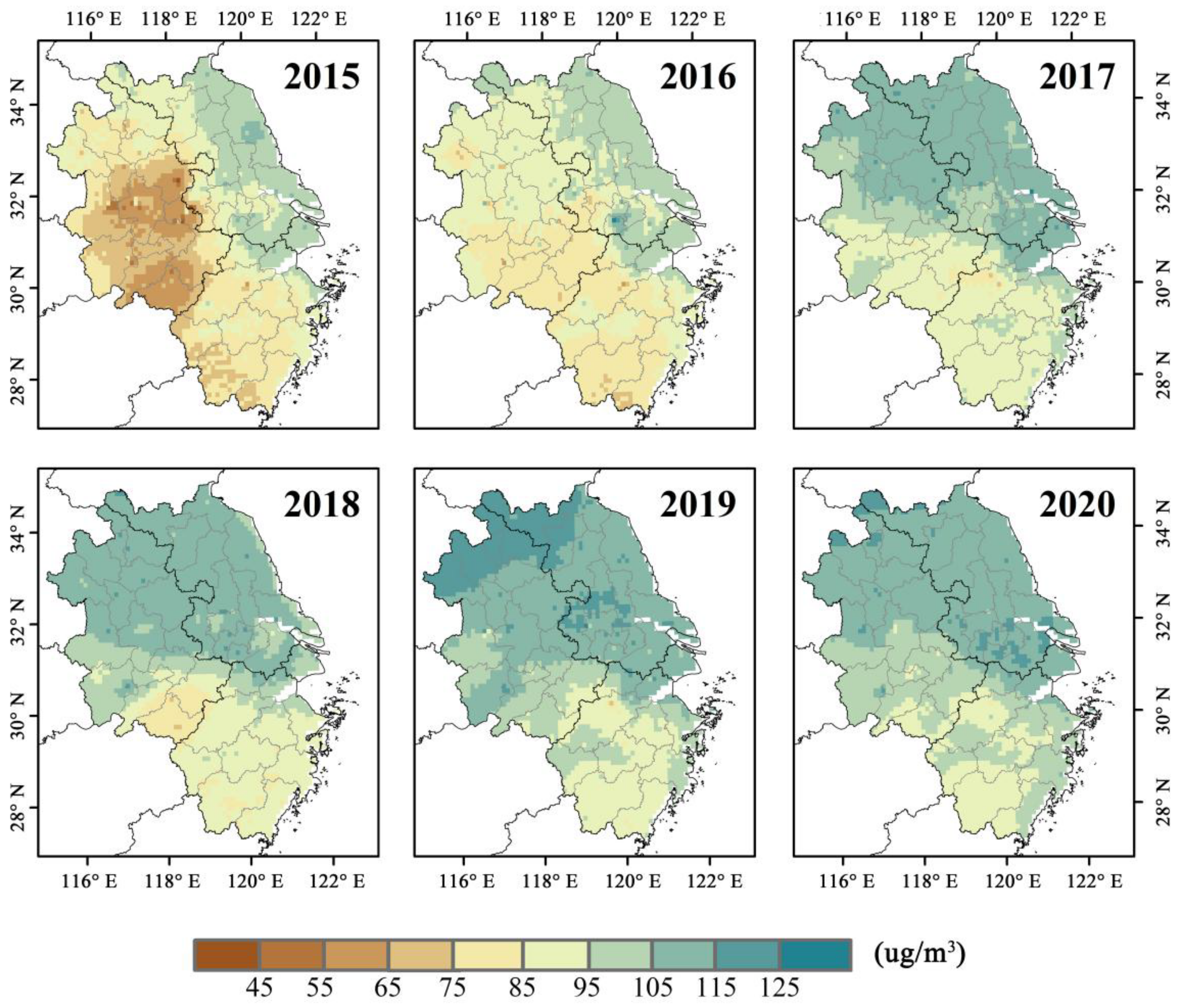
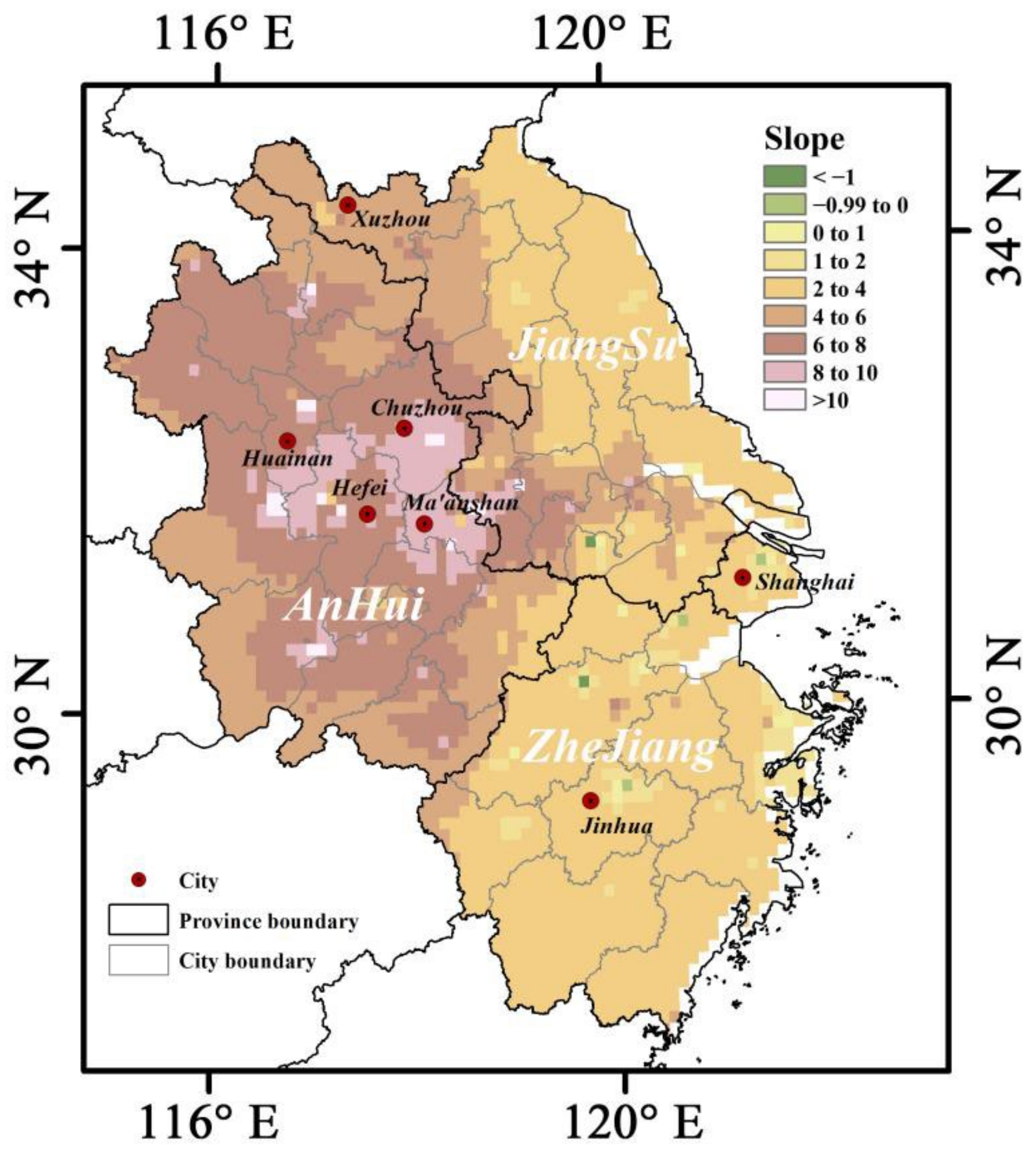
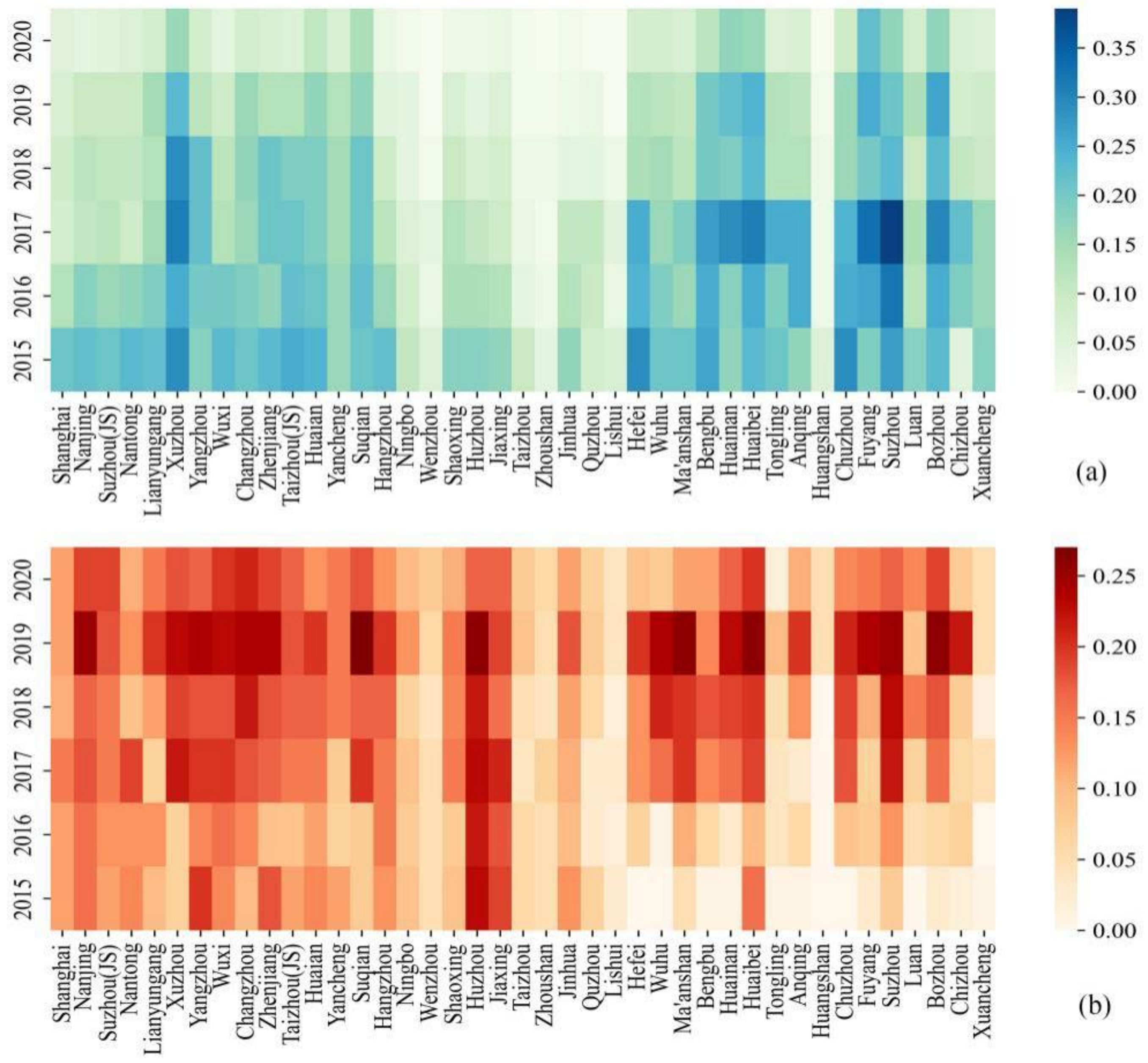

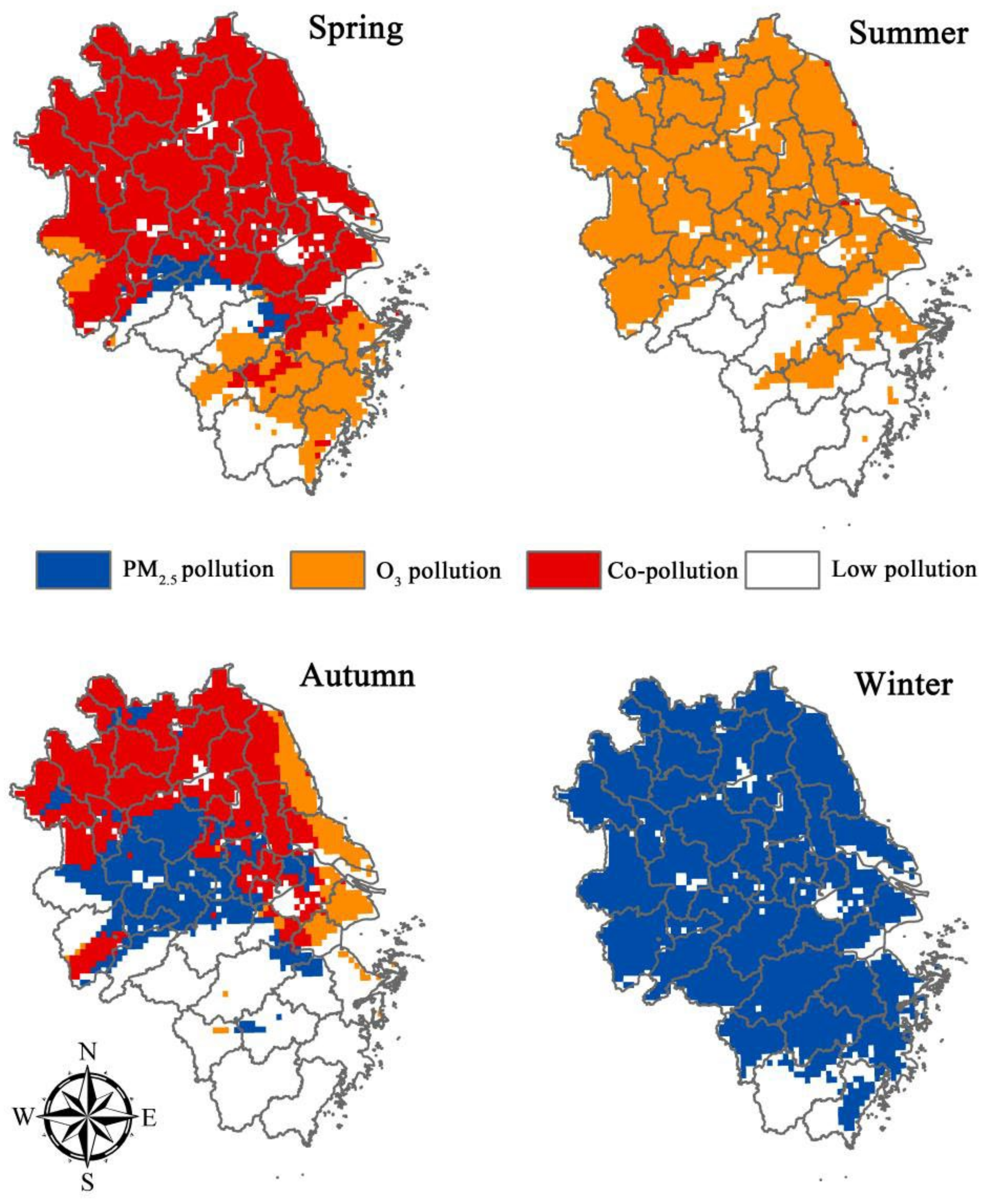

| Condition | Concentration (ρ) | Variation (cmean) * | |
|---|---|---|---|
| Excessive | ρ(pol) ≥ T(pol) | cmean(pol) > 0 | |
| ρ(pol) ≥ V(pol) | cmean(pol) < 0 | ||
| Non-excessive | ρ(pol) ≤ V(pol) | cmean(pol) > 0 | |
| ρ(pol) ≤ T(pol) | cmean(pol) < 0 | ||
| Transitional | Excessive to non-excessive | T(pol) < ρ(pol) < V(pol) | cmean(pol) < 0 |
| Non-excessive to excessive | V(pol) < ρ(pol) < T(pol) | cmean(pol) > 0 | |
| Pollution Type | Condition |
|---|---|
| High PM2.5 pollution | |
| High O3 pollution | |
| High co-pollution | |
| PM2.5 pollution to co-pollution | |
| PM2.5 to O3 pollution | |
| Co-pollution to O3 pollution | |
| PM2.5 pollution to low pollution | |
| Low pollution to O3 pollution |
| Pollution Type | Predicted | Actual |
|---|---|---|
| PM2.5 pollution | 1.8% | 0.3% |
| O3 pollution | 26.3% | 25.6% |
| Co-pollution | 41.9% | 40.4% |
| Low pollution | 30.0% | 33.7% |
Publisher’s Note: MDPI stays neutral with regard to jurisdictional claims in published maps and institutional affiliations. |
© 2022 by the authors. Licensee MDPI, Basel, Switzerland. This article is an open access article distributed under the terms and conditions of the Creative Commons Attribution (CC BY) license (https://creativecommons.org/licenses/by/4.0/).
Share and Cite
Wang, L.; Zhang, Z.; Gu, Z. Demarcation of Coordinated Prevention and Control Regions in the Yangtze River Delta Based on Spatio-Temporal Variations in PM2.5 and O3 Concentrations. Atmosphere 2022, 13, 1300. https://doi.org/10.3390/atmos13081300
Wang L, Zhang Z, Gu Z. Demarcation of Coordinated Prevention and Control Regions in the Yangtze River Delta Based on Spatio-Temporal Variations in PM2.5 and O3 Concentrations. Atmosphere. 2022; 13(8):1300. https://doi.org/10.3390/atmos13081300
Chicago/Turabian StyleWang, Leilei, Zhen Zhang, and Zhengnan Gu. 2022. "Demarcation of Coordinated Prevention and Control Regions in the Yangtze River Delta Based on Spatio-Temporal Variations in PM2.5 and O3 Concentrations" Atmosphere 13, no. 8: 1300. https://doi.org/10.3390/atmos13081300






